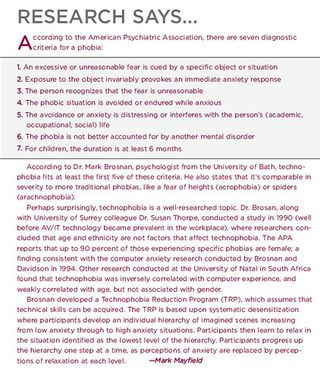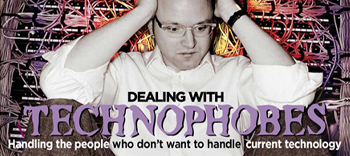by Tom Zind
Over the decades, technology has helped eradicate or stifle any number of human afflictions, from polio to measles to malaria. But there's one that technology hasn't dented - in fact, it's one that has technology as its root cause.
Technophobia, loosely defined as an inordinate fear of or resistance to using technology, is still with us despite its increasing ubiquity in homes and in the workplace. Sufferers can be as immovable and contrary as ever, as the senior educational technology engineer at the University of Notre Dame, South Bend, IN, discovered.
Once, in the course of explaining how to operate a new classroom AV control system to an instructor, Rick Nimtz got a glimpse into the mindset of the technophobe. "As I was explaining it, he started speaking in Spanish, and I told him I didn't understand what he was talking about," says Nimtz. "Then he says, 'Hey, just listen closely and pay attention; it's easy to learn.' That humbled me a little bit."
Translation: Technology may be approachable for many, but for others it can be as confusing, frustrating, and scary as being dropped into a foreign country.
Indeed, even as technology crowds its way into our lives, forced immersion has hardly immunized everyone from "technophobia." Attrition, innovation, and the march of time have thinned their ranks and eased their discomfort, but technophobes are alive and, arguably, well, complicating the lives of technology users and purveyors in the process, not to mention their own.
Technophobia probably goes back to the early days of telegraph and telephony. Its modern roots can be traced to the dawn of the personal computer. But advanced AV tools are fast becoming the new bogeyman for many who fear or resist technology. Even as AV puts the more practical and useful face on technology that everyone has sought by revolutionizing entertainment, education, and communication, to technophobes it's a whole new source of jitters.
But AV's increasing prevalence means it's harder than ever for technophobes to hide, especially in settings where it's becoming part of the backdrop. In environments ranging from the classroom to the business meeting to the courtroom, the technophobe of varying stripes is evolving from a harmless curiosity to a real nuisance and potential roadblock for institutions, co-workers, and technology managers.
INSTITUTIONAL TECHNOPHOBES
At Notre Dame, Nimtz has had his share of struggles introducing AV technology into classrooms. While he has introduced classroom lecterns with built-in controls for DVD and VCR players and ceiling-mounted projectors and document cameras, more than a few instructors were brought along kicking and screaming. Some, he says, either didn't see a need for AV technology or balked at investing the time needed to learn it.
"It seems like the longer someone has been teaching, the less apt they are to accept it, and part of the reason is the amount of work involved," Nimtz says. "It does take time to learn it and also develop lesson plans to work with technology."
Others, like an instructor who labored over a detailed, color-coded diagram of the Civil War on 30 feet of blackboard space as Nimtz taped his class, just prefer doing the things the old-fashioned way. A new source of instructor pushback is coming as Nimtz tries to introduce electronic whiteboard technology.
"A lot still like chalk, and the reason is that they know when they walk into a classroom that it's going to work," he says. "With a whiteboard they're never totally certain."
But avoidance is fast becoming a luxury that those who fear or resist the march of AV technology can no longer indulge. So it's falling to Nimtz and other institutional technology managers to develop strategies to bring existing technophobes along and ensure that the pace and manner of technology implementation is calibrated to ensure new technophobes aren't created.
One pillar of the approach is a clear communication of technology's benefits. Technophobes have typically defended their stance by arguing that technology is just so much gimmickry. The world worked fine without it, they say, and besides, what's the difference if they just choose not to participate. The only way some technophobes can be "cured," some managers say, is by showing them that technology can make a demonstrable difference.
In the educational arena, where committed teachers are constantly searching for better ways to impart knowledge, showing technophobes the difference technology makes shouldn't be hard, says Randy Jackson, assistant director of technology services for the University of Washington, in Seattle. With AV technology continuing to prove its value as an instructional tool, Jackson believes even the most technophobic instructors can be coaxed into letting down their defenses. A lot of it depends on how skilled implementers are in selecting technology and framing its introduction, he says.
"You have to promote the benefits, bring it back to the idea that technology can make learning more exciting and teaching easier," says Jackson. "Make that the goal, not the successful rollout of another piece of technology for technology's sake."
If technophobes in the educational arena can't be sold solely on AV's ability to improve how instructors teach, they might be swayed by its impact on how students learn and what they expect. As new generations of ever more techsavvy students emerge, instructors will have to be able to use AV and IT tools to be taken seriously. For technophobes, the fear of being seen by students as incompetent or out-of-touch may trump fear of technology.
"Students are now so comfortable with technology that they expect to see things like PowerPoint and smartboards used in class," Nimtz says. "So I see a certain amount of instructors not wanting to be seen fumbling with technology. If they can see how technology relates to usability and enhancing their teaching capabilities, they'll be more inclined to learn it."
DEFEATING ANTI-TECHNOLOGY THOUGHTS
Some committed technophobes, though, insist that technology not only doesn't add anything useful, but that it's a net negative. Frederic Lederer, chancellor professor of law and director of the Center for Legal and Court Technology (CLCT) and the Courtroom 21 project at the College of William & Mary School of Law, Williamsburg, VA, says some technophobic legal professionals take the view that emerging AV presentation and distance conferencing technology in legal proceedings actually gets in the way.

"I've found that mediators, for instance, by and large find the concept difficult," Lederer says. "To them, mediation means having everyone in the same room and being able to have a conference at the water cooler. They have a general world view that technology is a barrier to those efforts."
In running CLCT and Courtroom 21, which are helping foster leading-edge courtroom technology adoption, Lederer says he's learning the importance of justifying and clearly demonstrating technology's utility. "There's a deep-seated disbelief among some attorneys that it's beneficial, so we have to educate as to why it should be used and how it can be helpful," he says. "Our hope at CLCT is that, regardless of how apprehensive some may be, they know it's a tool that at least sometimes is good."
While addressing "techno-skeptica" is part of the formula for dealing with technophobia, helping technophobes confront their fear of actually using AV technology still poses the biggest challenge. Whether the fear relates to "breaking" something, their ability to comprehend, learn, and use it, or uncertainty that it will work reliably, technology managers often must confront deep-seated apprehension.
Ernie Bailey, director of audiovisual services at the University of Arkansas for Medical Sciences, Little Rock, says he tries to keep a lid on staff technophobia by focusing on technology education and ease of use. A "Teaching With Technology Resource Center" helps educate and familiarize instructors with emerging classroom AV and IT. "We strive to make devices as user-friendly as possible so we don't see fear in the instructors' eyes when they walk into a classroom," he says. "Our rule for integrators that we hire to design new room systems is that it takes a minimum of two touches on a control panel to get an image on a screen."
ADDRESSING GLITCHES
Inevitably, though, technology will fail on occasion. When it does, technophobes need to be reassured that glitches can be quickly addressed. For that reason, says Jackson, technology managers must develop a robust support network that can swing into action to correct problems. More importantly, the existence of that support needs to be communicated.
"You can't just put this technology into a classroom and say, 'Here it is, figure it out,' and not provide any support on the back end," he says. "In the education arena, in particular, we need that capability to solve problems immediately because it's a fast-paced environment where classrooms can change over in 10 minutes."
While it's important to address technophobes' fears, Jackson cautions against going too far in "dumbing down" technology. For one thing, technophobes' ranks could thin as more people become ever more comfortable with technology, although he senses some may be perpetually behind as the pace of technological change quickens. Additionally, putting too much emphasis on user-friendliness may be shortsighted.
"In the education environment, you really need to have tools that are complex enough to really bring about deep changes in learning," he says. "That may mean having tools that require a steep learning curve, but which can bring about the goal of creating a more robust and interesting learning environment."
And overindulging technophobes also may amount to selling them and, indeed, even the human race short, Jackson adds. "Humans are adaptable and can learn to do complex things," he says. "The key to dealing with technophobia may be making the goal of learning and feeling comfortable with it so compelling that you'll invest the time and effort to overcome it."











